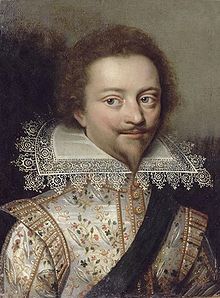Antoine Coëffier de Ruzé
Antoine Coëffier de Ruzé , Marquis d'Effiat (* 1582 in Effiat ; † July 27, 1632 in Lützelstein ), was a French aristocrat, military and politician. He was Surintendant des Finances , Grand Master of Artillery of France and Marshal of France .
Life
Antoine Coëffier is the son of Gilbert Coëffier, Seigneur d'Effiat, royal lieutenant in the Basse Auvergne, and Charlotte Gaultier. His paternal grandparents were Gilbert Coëffier d'Effiat, Seigneur d'Effiat, de La Bussière et de Chazelles, Trésorier de France and Général des Finances , and Bonne Ruzé. He was thus the great-nephew of Martin Ruzé de Beaulieu (around 1526-1613), the Grand Maistre, Superintendant and General Réformateur sur le fait des mines et minières du Royaume de France . Martin Ruzé died with no descendants and left his fortune to Antoine Coëffier on condition that he accept the name and coat of arms of his great-uncle. In addition, he managed to transfer his offices to Antoine.
In 1616 he was Premier Écuyer Louis XIII. In 1624 he entered the Council of State ( Conseil d'État ) at the same time as Cardinal Richelieu , who in the same year sent him to England as Envoy Extraordinary for the marriage of Henrietta Maria of France , the king's sister, with the Prince of Wales and later English King Charles I to negotiate. Thanks to the support of the cardinal, he became Surintendant des Finances on June 9, 1626 .
In 1626 he issued an edict on iron mines in order to achieve the reopening of closed mines by simplifying the administrative burden for the farmers. In 1629 he had - after being contacted by the hydraulic engineer Hugues Cosnier - the work on the Canal de Briare ("Canal de Loyre en Seyne"), one of the canals with which the navigation from the Seine to the Saône and thus between the English Channel and the Mediterranean is made possible should resume, which had been interrupted in 1610 after the murder of King Henry IV ; due to his death he did not see the completion in 1642. Cardinal Richelieu was the first famous passenger on this canal when he returned sick from the siege of Perpignan (1642) after having executed in Lyon the conspirators François Auguste de Thou and Cinq Mars , the son of Antoine Coëffier.
On the military side, he distinguished himself at the siege of La Rochelle (1627-1628) , in which he played a decisive role. In 1629 Antoine Coëffier was appointed Grand Master of the Artillery of France . During the Italian campaign of 1630 he was sent to the army as a lieutenant general , with whom he took part in the battles of the Battle of Avigliana and the Battle of Carignan . In January 1631 he was appointed Marshal of France . In 1632 he was in command of the army that had been sent to recapture the residence of Philipp Christoph von Sötern , the archbishop of Trier . During this campaign he died in Lützelstein in Alsace of an inflammatory fever.
He left behind the Mémoires sur les guerres et les affaires du temps printed in 1622 , the expanded Effiat Palace , the newly built Effiat there , to which he had donated a hospice and a college of the Congregatio Oratorii Iesu et Mariae . His heirs were his eldest son Martin Ruzé as Marquis d'Effiat, as well as his grandson Armand-Charles de La Porte , born 1664 a year before his death, Duc de la Meilleraye, who married Hortense Mancini in 1661 , one of the nieces of Cardinal Mazarin , who the titles of Marquis de Longjumeau et, de Chilly , Baron de Massy, accrued; these titles are held today by his descendants, the princes of Monaco .
marriage and family
The Marquis d'Effiat had married Marie deFourcy. Your children are:
- Martin Ruzé (* 1612, † 1645), Marquis d'Effiat, royal lieutenant in Auvergne ; ⚭ 1637 Elisabeth / Isabelle d'Escoubleau, daughter of Charles d'Escoubleau, Marquis d ' Alluye ( Perche-Gouët );
- Marie Ruzé (* 1614, † 1633), ⚭ (1) Gaspard d'Alègre, Sieur de Beauvoir; ⚭ (2) Charles de La Porte , later Duc de la Meilleraye and Pair de France , Marshal and Grand Master of the Artillery of France
- Charlotte Marie de Ruzé (* 1615, † 1692), nun, founder of a convent of the Congregation Filles de la Croix (de Paris), founded in 1641 in the Faubourg Saint-Antoine in Paris
- Henri Coiffier de Ruzé d'Effiat (* 1620, † 1642), Marquis de Cinq-Mars, beheaded in Lyon on September 22, 1642
- Jean Coëffier called Jean Ruzé d'Effiat (* 1622, † 1698), Benedictine , 1641–1643 Abbot of Mont-Saint-Michel .
literature
- François-Alexandre Aubert de La Chenaye-Desbois , Dictionnaire de la noblesse , Volume 5, La Veuve Duchesne, Paris, 1772.
- Jean-Baptiste Bouillet, Nobiliaire d'Auvergne , Volume 2, Perol, Clermont-Ferrand, 1847.
Individual evidence
| personal data | |
|---|---|
| SURNAME | Coëffier de Ruzé, Antoine |
| ALTERNATIVE NAMES | Coëffier de Ruzé, Antoine, Marquis d'Effiat |
| BRIEF DESCRIPTION | French aristocrat, military and politician |
| DATE OF BIRTH | 1582 |
| PLACE OF BIRTH | Effiat |
| DATE OF DEATH | July 27, 1632 |
| Place of death | Lützelstein |
